First off, in the past few days we have had a number of people ask for a trailer for the first episode of InRange that actually provides a thorough idea of what is in the show. The initial trailer was cut to look exciting and hip, and I’ll admit that it really didn’t say much about the show content. So, we put together a second extended trailer, which is a full 15 minutes long – meaning it is a full quarter of the show. It does, I think, a much better job of conveying the show content:
Like what you see? Check out the full episode, and tell your friends!
Blatant self-promoting ad out of the way now, I do also have some old-gun material to post. My friend Hrachya sent over some documents in light of the recent Madsen SMG video, including a neat catalog of pretty much all the guns offered by the Madsen company after WWII. It’s a fun piece to flip through, and it made me realize that there is now information here on almost every one of them…
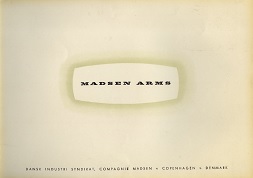
One of the items in the catalog that jumped out at me in particular is the “Madsen-Ljungman Semi-Automatic Rifle”:

It is clearly a Ljungman rifle, but not quite the same as what the Swedes produced. Little details like the magazine profile and handguard vents are different. It would appear that the Madsen company got themselves a license ot produce Ljungman rifles, but was unable to garner any contracts for them – I’m not aware of any of these rifles ever being manufactured (and note that in the catalog, they are listed as being available in your choice of caliber, between 6.5mm and 8mm).
The 50mm mortar is also an interesting piece, which I have not gotten to see in person, not found other information about.
Anyway, for more info on Madsen company check out these previous posts:
M47 Lightweight Military Rifle (bolt action)
INA 953 (Brazilian copy of the Madsen SMG)
Madsen M50 (SMG)
Madsen-Rasmussen 1888 and 1896 (semiauto rifles)
Madsen LMG (including belt-fed tank model)
Madsen-Saetter (belt-fed)
Update
Ruy points out that the Danish State Defense History Museum has photos of two of the Madsen-Ljungman rifles. One is in 7.65mm (presumably in an effort to secure South American contracts) and one in 7.62mm (it’s dated 1950, which would make that .30-06 caliber). Thanks, Ruy!
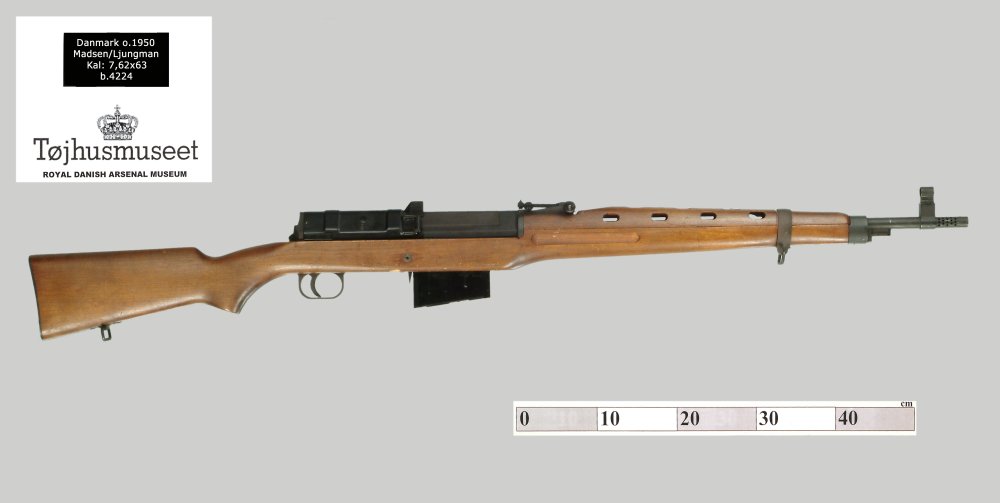
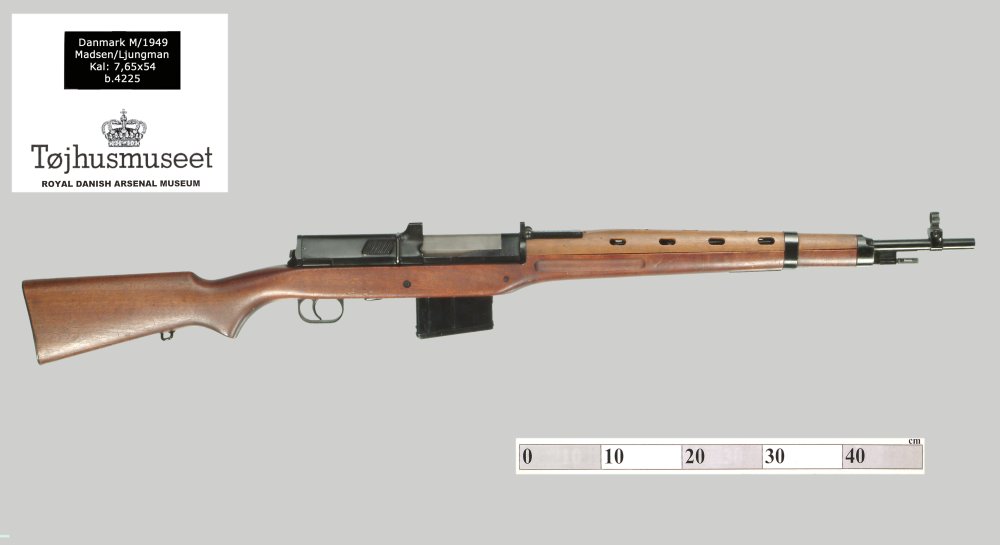

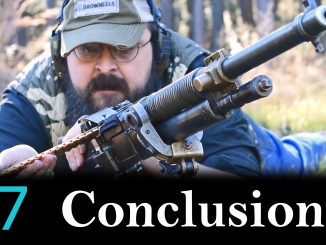

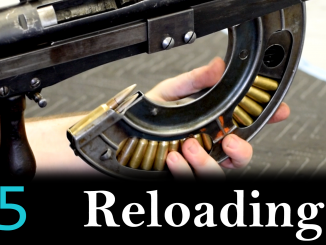
I’ve always loved the Model 1923 helmet from Denmark! Way cool!
I agree that the 50mm mortar/grenade launcher is an extremely interesting weapon. The swing-out breech looks a bit like a medieval bombard to my mind, but then again, it does prefigure the current under-barrel 40mm grenade launchers that swing out to the side for loading…
Interesting that the M47 lightweight military rifle–sold pretty much only to the Colombian Navy and perhaps a few other nations not laden with Mauser service rifles in the post-WWII period–was intended for short statured users! As surplus, a number of these were actually purchased and used as a patrol rifle by U.S. police departments.
The Brazilian INA 953 was in .45 acp. It is the one weapon singled out by the “Mini-manual of the urban guerrilla” by Carlos Marighela as “ideal” for urban guerrilla/terrorist operations in Brazil’s cities and sprawling favelas/mega-slums.
Great posts, Ian! Thanks!
It must be a spigot mortar I think, interesting contraption… Sort of a PIAT/mortar.
I briefly pondered the use of a Martini style action in an autoloader on occasion myself, it never developed into anything particularly. I wasn’t aware the Madsen LMG operated in that manner, interesting mechanism.
If I get this credit card I applied for, I look forward to watching Inrange TV I am sure it will be a good show.
Speaking of pondering firearm mechanisms,
http://s1142.photobucket.com/user/patrickmurphy3/media/NA/WP_20140914_005.jpg.html
there’s a link to a doodle in my photobucket album which shows my reworked Gerat06H action there’s a photograph of a basic model also. I would be interested if anyone has any thoughts about it’s potential feasibility for recoil operation, it would be constructed out of flat metal plates pinned together with four rollers on the ends of the pins.
The locking surfaces are two halves of a steel box sections with there front edges ground down to form angled surfaces, bolt face at one end, weight/buffer at the other. Fits inside a tubular receiver, with the weight resting against the recoil spring out of interest.
“I wasn’t aware the Madsen LMG operated in that manner, interesting mechanism.”
Here: http://world.guns.ru/machine/dk/madsen-e.html is drawing explaining principle of operation of Madsen LMG.
Cheers, handy pictures.
As for the Madsen/Ljungman AG42 clone, I guess the Swedes scooped ’em by helping Egypt build the 7.92x57mm Hakim rifle with the Ljungman (and French MAS Mle.1940 and 44 and 49) action, no?
The DISA AG42 was in fact a licence-made version, which the company hoped could be sold to any governments willing to equip their militaries with a good quality self-loading rifle; not a very good idea for commercial success when the world was just being flooded with WW2 surplus, including good M1s (for governments friendly to the US, of course). Also it might explain why the Swedes never exported their AG42 (except for the technical assitance to the Egyptians with their Hakim in 8mm Mauser).
The Danish Statens Forsvarshistoriske Museum has two specimens of the Madsen/Ljungman made by DISA:
– one in (presumably) .30-06 (then, circa 1950, the standard LMG and rifle calibre of the Danish armed forces):
http://www.thm-online.dk/genstande/54-b4224/
Some parts of this rifle have a grey/olive parkerized finish as in some Madsen M 1947 bolt action short rifles.
– the other in 7.65 Argentine, possibly in an attempt to win some contracts in South America (Peru, Argentina…)
http://www.thm-online.dk/genstande/54-b4225/
In this case, the barrel, receiver, forend cap, forend band and trigger group/magazine assembly seem finished in black enamel.
In the same period, FN fared much better than DISA with their FN49.
Here is some more info on that mortar:
http://www.network54.com/Forum/330333/thread/1178483049/Madsen+51mm+mortar
https://www.youtube.com/watch?v=FcBFz-AbayU
https://www.youtube.com/watch?v=jfAcWCPErMo
It probably had rifling in the front “barrel” section, a sort of rifled PIAT, mortar.
Nope, the bombs where fin stabilized.
You are welcome, Ian!
Incidentally that sawback bayonet would be quite good for tackling Zombies with…
If you used say an Ingram model SMG because of the trigger arrangement presumably for full auto, and the same bolt, I assume you have to use the same bolt for it to be legal something to do with the 1986 ban on automatic weapons. Could you have anything else you wanted up front, i.e. A calibre change, a rifle cartridge which had a base diameter compatible with the original calibre? If so, you could have the barrel move inside a new upper receiver along for example. Then have a locking method that engaged with the original bolt i.e. Behind it, avoiding any modifications to it. If you could do that, all you need then is a belt feed mechanism and you could have a fun accessory.
Thinking an Fn Fal bolt, sat above the original bolt… With the Fn’s bolt acting as the locking piece for the original bolt i.e. The bit that would contact the frame usually would lock the bolt, until it was lifted up out of it’s way… The usual bit that contacted the frame would sit above the original bolt as it passed below it, until it returned. The Fn bolt, could rest on a pin passing through the receiver “to lock it, until lifted” it wouldn’t need to move anymore than the was required to free the actual bolt… The fn bolt could be sprung loaded from behind, and could be actuated by the barrel initially, until the barrel returned separately, be ways.
In the US the gun is the receiver, the receiver the forging or casting or piece of sheet metal that has the serial number stamped on it; normally it would house the fire control group. Generally speaking, receivers of guns sold as semi-autos in the US must be incapable of readily accepting full-auto fire control parts.
Bolts and calibers are of no legal importance.
On the Inrange Tv trailer, there’s a Mac lower attached by the original takedown pin to a new upper which accepts a drum mag. Are you saying Jacob that you could fit, a purposely designed new “locking” bolt into the upper to fire say 5.56mm which was operated by the fire control mechanism of the full auto Mac then to clarify out of interest?
Yes.
A further clarification: it was in the mid-1930’s when the first US federal gun law was enacted. It was written in response to the prohibition era gangsters. Most of the gangsters used pistols, mainly to kill each other, but there were a few instances of real machine guns being used against law enforcement. The law did not ban anything, but subjected machine guns, silencers, short barreled rifles and shotguns to what was then a very high transfer tax. The tax was high enough ($500 I think) that it was effectively a ban.
The years of inflation over the next half century reduced the prohibitive tax into a merely annoying tax. What the 1986 law did was to ban any additional machine guns from entering the civilian market. Machine guns already legally owned (“on the register”) can be bought and sold (to a person who can secure the transfer paperwork–which involves a back ground check, clearance from local law enforcement, etc.), but nothing can enter that market if it was not there in 1986. However, new silencers and short barreled long guns can still enter the market place.
Al Capone with the Tommy gun in a Violin case eh… Mind you he probably could afford $500 at the time, although maybe not at the point when he wanted one.
If you have a pre 86 registered Mac, and the hammer breaks can you make a new one and fit it or do you have to find an original spare?
It may be $200, not $500, at any rate it was a lot of money when a worker may have made a dollar a day.
I’m not an expert on NFA guns, but my understanding is that any part can be replaced, and it can be a newly made part, so long as it is not the reciever itself. The availability of spares, and how easy those spares can be installed, would be an issue for someone contemplating an NFA purchase if they were planning on shooting it much.
I just had a look at your In Range web site. There’s nothing there which tells someone *how* to buy a downloadable copy. I was able to figure it out by clicking around, but it’s not obvious. Some of your potential customers may not figure it out and give up.
I would suggest adding a brief blurb on what the process is, plus also a more in-depth explanation on another page. You really want to make the process as simple and painless as possible. A lot of your potential customer base are going to be people who are not comfortable with computers and may never have purchased a video on line before.
I don’t need any help with this myself, but I just wanted to point out something that needs improvement. Good luck with your new venture!
Looks interesting and I wish you well with it. That said, I won’t be watching because I’d rather apply that $3 to my insanely limited budget for things like bullets, primers, dies and such so that I can actually shoot the firearms I have. I work full time and barely make enough to pay my bills and child support so something, like TV shows, are simply luxuries that have to be done without.
Saw the first episode and I’m looking forward to others.
It solves a dilemma: the only way to get the firearms shows on TV (through AT&T or DirecTV anyway) is to go with one of the more expensive packages, $80+ range. Of those shows there is more fluff than substance. The shows on cable have good production quality, but are designed for people with short attention spans, and have more booms and bangs than actual information. In light of that, $3 / month is not a bad deal at all.
The interview with the AK specialist was great, he obviously had tremendous experience and I learned more from that interview than I would have by spending a few dozen hours reading AK forum posts, half of them written by arm chair commandos.
Hey Ian, feel free to post the manual for the 51mm mortar I posted in the premium forum.
Re the saw-back bayonet segment, I have seen a few of these (German issue) in museums here in Australia. Very nasty looking item indeed. The segment reminded me of something I read a few years back, concerning an incident on the western front in WW1. In this incident, a group of Australian soldiers were taking the surrender of a number of German soldiers. As the Germans were coming out of their position, one of them suddenly fired his weapon at the Australians, and then threw his weapon down and his hands up. The shot hit and killed an Australian sergeant, who was apparently well-liked by his men. An enraged Australian soldier then took one of these saw-back bayonets and cut the offending German’s head off. War is a terrible thing.
I just found a recent photo of a Madsen-Saetter GPMG; apparently, a few can still be found being used by the Indonesian armed forces:
https://www.flickr.com/photos/thesamperuru/1881576791/in/photostream/
the 7.62 photo is marked as 7.62×63, which is Euro-speak for .30-06, which removes any doubt.
Interestingly, the Danes issued .30-06 and 7.62×51 NATO Garands – I have one of the latter, made by Beretta. For some inexplicable reason, the barrel is half an inch shorter, under the rear handguard (thus implicating as many components as possible – stock, rear handguard, op-rod, spring). I guess the Italians thought “the cartridge is half an inch shorter, so the barrel should be too”.
Anyway, the two 7.62mm ammunitions in Danish service were 7.62mm M 5-something, and 7.62mm M 6-something. Confusing, much?
Given the very real danger of a slamfire of a .30-06 cart in a 7.62 NATO rifle (exacerbated by the similar designations), there’s a filler block in the front of the magazine. Contrary to popular belief, it’s not a feedramp to help feeding of the shorter cartridge – it’s not touched by the cartridge, and has no brass track on it. The rifle works perfectly without it (like the US Navy ones), but it prevents a clip of .30-06 from going in.